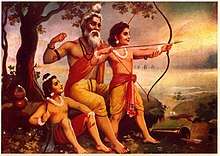Lava (''Ramayana'')
| Lava | |
|---|---|
 | |
| Texts | Ramayana |
| Personal information | |
| Born | Valmiki's ashram, Brahmavart, Kingdom of Kosala (present-day Bithoor, Uttar Pradesh, India) |
| Parents | |
| Siblings | Kusha |
| Dynasty | Raghuvanshi Ikshvaku Suryavanshi |
Lava [1] (Sanskrit: लव) and his twin brother Kusa, were the children of Rama and Sita. Their story is recounted in the Hindu epic, the Ramayana. Lava was younger of the two and is said to have a wheatish golden complexion like their mother, while Kusha had a blackish complexion like their father.
Lava is purported to have founded Lavapuri[2] (the modern day city of Lahore),[3] which is named after him.[4] The Sikarwar Rajputs, the Lohana, Awadhiya and Leva Patidar are present-day Indo-Aryan ethnic groups who claim their descent from Lava. Lava belongs to the Ikshvaku clan or Suryavansha Dynasty of Kshatriyas in ancient India.[1][5][6]
Birth and childhood


According to the Ramayana, Sita was banished from the kingdom of Ayodhya by Rama due to the gossip of the kingdom folk. She took refuge in the ashram of Sage Valmiki located on the banks of the Tamsa river.[7] Lava and Kusha were born at the ashramam and were educated and trained in military skills under the tutelage of Sage Valmiki. They also learned the story of Rama.

Later history
Lava and Kusha became rulers after their father Rama and founded the cities of Lavapuri (current day "Lahore") and Kasur respectively. The king of Kosala Raghava Rama installed his son Lava at Sravasti and Kusha at Kushavati.[8]
There is a temple associated with Lava (or Loh) inside Shahi Qila, Lahore.[9]
See also
References
- 1 2 Lohana Community United Kingdom
- ↑ Bombay Historical Society (1946). Annual bibliography of Indian history and Indology, Volume 4. p. 257.
- ↑ Baqir, Muhammad (1985). Lahore, past and present. B.R. Pub. Corp. pp. 19–20. Retrieved 2009-05-29.
- ↑ Masudul Hasan (1978). Guide to Lahore. Ferozsons.
- ↑ Diwan Bherumal Mahirchand Advani. Trans. by Narain Sobhraj Kimatrai. The Source of Sindhi Surnames. Chapter 6. 1947.
- ↑ Leva Gurjars ancestry
- ↑ Vishvanath Limaye (1984). Historic Rama of Valmiki. Gyan Ganga Prakashan.
- ↑ Nadiem, Ihsan N (2005). Punjab: land, history, people. Al-Faisal Nashran. p. 111. Retrieved 2009-05-29.
- ↑ Ahmed, Shoaib. "Lahore Fort dungeons to re-open after more than a century." Daily Times. November 3, 2004.
.jpg)